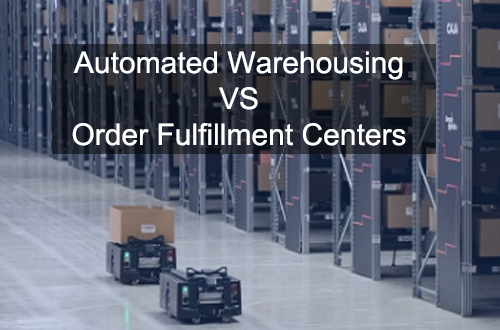Difference Between Automated Warehousing & Order Fulfillment Centers
With the rapid development of e-commerce, logistics and supply chain management have become increasingly important. To improve efficiency and accuracy, many businesses are turning to automation technology to optimize their warehousing and order processing processes. Two key components of this growing landscape are automated warehousing and fulfillment centers. In practice, however, there are some clear differences between automated warehousing and fulfillment centers.
Automated warehousing and order fulfillment centers are logistics facilities that use automated technology to manage inventory and shipments.
How automated warehousing differs from fulfillment centers?
Characteristics of automated warehousing
The main purpose of automated warehousing is to effectively manage and organize products within the warehouse. Customers usually store goods in the warehouse for a long time. Facilities that mainly focus on inventory storage and management are equipped with automated systems to perform inventory tracking, storage and retrieval, etc. Task.
Typically located near production sites or transportation hubs to reduce transportation costs and increase efficiency, and to simplify the storage and retrieval of goods.
Automated warehousing mainly includes functions such as purchasing, storage, inventory, and allocation. It is usually larger than automated order fulfillment centers because they need to store more inventory and more types of goods. They can minimize human intervention in daily tasks and Improve inventory accuracy.
Characteristics of Fulfillment Centers
Fulfillment centers go beyond warehousing and integrate other processes such as picking, packaging and shipping of products. These centers are designed to handle the entire order fulfillment process from order placement to final shipment.
The main purpose of order fulfillment centers is to facilitate the customer experience and order delivery process. They are more focused on inventory turnover and are therefore used for short-term storage of goods. They are also smaller than automated warehousing because they only need to store high-demand goods and a small amount of spare inventory.

Fulfillment centers often employ advanced automation technology, including order-picking robots, automated packaging systems, and conveyor systems, to facilitate efficient order processing. Customer-centric and focused on providing timely and accurate order fulfillment. The goal is to meet customer expectations for fast, accurate delivery.
In addition to storage and retrieval, order fulfillment centers focus on end-to-end order processing. This includes picking items from the shelves, packing them into boxes, and preparing them for shipping. The functions of the automated order fulfillment center mainly include picking, packaging, shipping, returns, etc. Fulfillment centers are often located in multiple locations near customers to reduce delivery times and increase satisfaction.
How does warehouse automation differ from traditional warehouse operations?
Warehouse automation involves the use of advanced technology and robotic systems to optimize various tasks within the warehouse, such as inventory management, order picking, and goods handling. Unlike traditional warehouse operations, automation increases efficiency, accuracy, and overall warehouse productivity.
Are there any fulfillment service providers in China that provide automated warehouse using systems?
Yes, there are many fulfillment service providers in China that provide automated warehousing systems. For example: chinadivision provides various automated warehousing solutions to help companies realize warehousing automation and intelligence.
How to choose between automated warehousing or fulfillment centers?
Choose to use automated warehousing
- If the enterprise's warehousing needs are relatively simple and only require basic cargo storage and retrieval, then automated warehousing may be a suitable choice.
- If the company already has advanced automation equipment and technology, such as robots, unmanned trucks, etc., or needs to improve efficiency and accuracy, then automated warehousing may be a good choice.
- Automated warehousing usually requires higher initial investment for the purchase and installation of automation equipment and systems. However, in the long run, automated warehousing can increase efficiency and accuracy, thereby reducing operating costs.
When you choose to use a fulfillment center
- The order processing needs of the enterprise are relatively complex and a large number of orders need to be processed quickly and accurately, so the order fulfillment center may be more suitable.
- If the company has low technical requirements, or does not want to invest too much in technology and equipment, it is more convenient and efficient to directly outsource and choose an order fulfillment center.
- If the company has sufficient budget and hopes to reduce costs through long-term operations, then choose to use an order fulfillment center.
- Order fulfillment centers usually have high flexibility and can quickly adapt to enterprise business changes and demand changes. If the company's business changes frequently or the order processing process needs to be adjusted quickly, then an order fulfillment center may be more suitable.
While both automated warehousing and fulfillment centers use automation to improve efficiency, the main difference lies in their primary functionality and focus. Automated warehousing centers on the storage and management of inventory, while order fulfillment centers address the entire process of receiving, processing, and shipping customer orders.
When choosing between automated warehousing or fulfillment centers, companies need to consider factors such as their business needs, technology requirements, cost considerations and flexibility, and conduct a comprehensive evaluation and comparison. The final choice should be based on the actual situation and long-term development goals of the enterprise.





